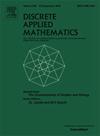图的近间隔边着色
IF 1
3区 数学
Q3 MATHEMATICS, APPLIED
引用次数: 0
摘要
图的区间边着色是用整数进行的适当的边着色,使得与任意顶点相关的边上的颜色形成一个整数的区间。并非所有的图都是区间可着色的;一个简单的反例是K3。近区间着色是图的一种适当的边着色,使得与任意顶点相关的边上的颜色要么是区间,要么是近区间,其中近区间是除一个缺失整数以外的区间。我们证明了所有最大次为4的图,以及所有最大次为5且没有顶点为3的第1类图都是近区间可着色的,从而改进了Petrosyan et al.(2010)先前的结果。我们还考虑了近区间着色外平面图的问题。对于二部图,我们证明了每一个最大次不超过5的二部图都有近区间着色,并且对于每一个Δ≥18,都存在一个最大次Δ的二部图没有近区间着色。对于二部多图,我们给出了对于每个Δ≥15的最大度Δ无近区间着色图的类似例子。最后,我们给出了允许近区间着色的最大次为6、7和8的二部多重图的类别。本文章由计算机程序翻译,如有差异,请以英文原文为准。
Near-interval edge colorings of graphs
An interval edge coloring of a graph is a proper edge coloring by integers such that the colors on the edges incident with any vertex form an interval of integers. Not all graphs are interval colorable; a simple counterexample is . A near-interval coloring is a proper edge coloring of a graph such that the colors on the edges incident with any vertex is either an interval or a near-interval, where the latter is an interval except for one missing integer.
We prove that all graphs of maximum degree at most 4, and all Class 1 graphs of maximum degree 5 and no vertices of degree 3 are near-interval colorable, thereby improving previous results by Petrosyan et al. (2010). We also consider the problem of near-interval coloring outerplanar graphs. For bipartite graphs, we prove that every such multigraph of maximum degree at most 5 admits a near-interval coloring, and that for every there is a bipartite graph of maximum degree with no near-interval coloring. For the case of bipartite multigraphs, we give analogous examples of graphs of maximum degrees with no near-interval coloring for every . Finally, we present classes of bipartite multigraphs of maximum degree 6,7 and 8 that admit near-interval colorings.
求助全文
通过发布文献求助,成功后即可免费获取论文全文。
去求助
来源期刊

Discrete Applied Mathematics
数学-应用数学
CiteScore
2.30
自引率
9.10%
发文量
422
审稿时长
4.5 months
期刊介绍:
The aim of Discrete Applied Mathematics is to bring together research papers in different areas of algorithmic and applicable discrete mathematics as well as applications of combinatorial mathematics to informatics and various areas of science and technology. Contributions presented to the journal can be research papers, short notes, surveys, and possibly research problems. The "Communications" section will be devoted to the fastest possible publication of recent research results that are checked and recommended for publication by a member of the Editorial Board. The journal will also publish a limited number of book announcements as well as proceedings of conferences. These proceedings will be fully refereed and adhere to the normal standards of the journal.
Potential authors are advised to view the journal and the open calls-for-papers of special issues before submitting their manuscripts. Only high-quality, original work that is within the scope of the journal or the targeted special issue will be considered.
 求助内容:
求助内容: 应助结果提醒方式:
应助结果提醒方式:


